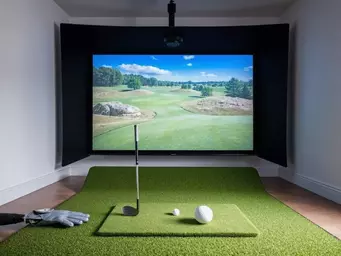Understanding Golf Course Management

Understanding the layout of a golf course is crucial for improving your gameplay and strategy. By recognizing each hole's unique features, you can enhance your experience and boost your confidence on the greens.
What You Will Learn
- Each golf course has a distinct layout that impacts shot strategy and decision-making.
- Familiarizing yourself with tees, fairways, and greens can significantly enhance your performance.
- Understanding golf course architecture helps you appreciate the design and strategy behind each hole.
- Analyzing hazards and terrain allows for more strategic shot planning and course management.
- Engaging with your local golfing community can provide insights and enhance your skills.
- Inclusivity features on women’s golf courses promote a more approachable and enjoyable experience for all players.
Key Elements of Effective Golf Course Design
Understanding the components and architectural considerations of a golf course layout is crucial for strategic play. The visual below highlights the primary elements that contribute to a well-designed course.
Course Components
- Tees: Start points
- Fairways: Path to green
- Greens: Putting area
- Hazards: Challenges
Architectural Considerations
- Strategic Placement
- Varied Terrain
- Visual Appeal
- Environmental Integration
Player Benefits
- Enhanced Strategy
- Improved Confidence
- Greater Engagement
- Better Decision-Making
Key Design Elements
- Accessibility for all
- Strategic Challenges
- Environmental Harmony
- Balanced Experience
Understanding Golf Course Layouts and Their Importance
Golf course layouts are like the blueprints of a sports symphony, guiding every player through a unique journey on the greens. Understanding a course layout is essential for golfers at all levels because it helps us determine our strategy before we hit that first tee. Just imagine standing on the first hole, the sun rising above the horizon, and you can already picture how each hole unfolds before you—this is the beauty of being aware of the course layout!
A golf course layout typically includes various components like tees, fairways, hazards, and greens. These elements come together to create a challenging yet enjoyable experience. Knowing how each section flows not only enhances our game but also boosts our confidence as we navigate through. For more detail on how golf courses contribute to local economies and environmental preservation, the Metropolitan Golf Association provides valuable insights.
What Is Golf Course Layout?
A golf course layout refers to the arrangement of the holes on the course, including the distance, direction, and design of each hole. Essentially, it encompasses everything from the tee box to the putting green. By understanding this layout, we can develop a game plan specific to each hole's demands.
- Tees: The starting point for each hole, influencing club selection and strategy.
- Fairways: The ideal area for our shots, serving as a pathway to the green.
- Greens: The final destination, where putting precision becomes crucial.
By recognizing these components, we gain the ability to strategize our shots, adapting to the unique challenges each hole presents. This insight transforms our gameplay from reactive to proactive!
The Role of Golf Course Architecture in Play
Golf course architecture plays a significant role in shaping our experience as golfers. Well-designed courses not only challenge our skills but also enhance our appreciation for the game. Architects carefully consider factors such as terrain, wind patterns, and natural landscapes to create layouts that promote strategic play. The Golf Course Superintendents Association of America (GCSAA) emphasizes the importance of sustainable design and maintenance in these architectural considerations.
- Strategic Placement: Hazards are placed to challenge players, forcing us to think critically about each shot.
- Varied Terrain: Elevation changes and natural features add complexity, testing our adaptability.
- Visual Appeal: Aesthetically pleasing designs can inspire and motivate us as we play.
By understanding the intent behind a course's design, we can better appreciate the art of golf and improve our decision-making on the course!
Key Elements of Effective Golf Course Design
Effective golf course design revolves around several key elements that together create a balanced and challenging experience. A well-thought-out layout considers the needs of all players, from beginners to seasoned pros.
- Accessibility: Courses should be playable for golfers of varying skill levels.
- Strategic Challenges: Incorporating a range of hazards and obstacles keeps the game engaging.
- Environmental Integration: Using the natural landscape enhances both playability and aesthetics.
Recognizing these elements can help us appreciate the nuances of our favorite courses while allowing us to navigate them with more insight and strategy!
Analyzing Key Components of Course Layouts
Now that we've established the importance of understanding golf course layouts, it’s time to dive deeper into the key components that influence our gameplay. Analyzing these elements can significantly enhance our approach on the course.
Pro Tip
To truly master the art of course management, take the time to walk the course before your round. Familiarize yourself with each hole's layout, noting the position of hazards and the slopes of the greens. This will not only enhance your strategy but also boost your confidence as you prepare to tackle each challenge head-on!
Summarizing Key Takeaways for Effective Course Management
As we reflect on the intricate layers of golf course layouts, it’s clear that understanding these structures can significantly enhance your overall game experience. Recognizing the layout isn’t just about knowing where the bunkers lie or how far the water hazard is; it's about developing a strategic mindset that shapes your shot selection and course management. Here are some key takeaways to help you grasp the value of your course's layout:
- Familiarize yourself with the unique features of each hole.
- Identify hazards and their potential impact on your shots.
- Master the greens by learning the slopes and pin positions.
- Plan your shots based on landing areas and tee box placements.
By embracing these insights, golfers can navigate their courses with greater confidence and precision. Remember, every round is a new opportunity to apply what you've learned!
The Value of Understanding Your Course's Layout
Understanding your course's layout is akin to having a roadmap for your journey on the greens. It allows you to make informed decisions that lead to better performance and more enjoyable rounds. The more you know about the specific challenges each course presents, the better equipped you will be to tackle them. Engaging with the course layout enhances not only your game but also your enjoyment of the sport itself.
From strategic shot planning to selecting the right club for each situation, every detail plays a vital role. Golfers who take the time to study course features often find themselves improving faster than those who rely solely on instinct. So, why not embrace this knowledge? It could be the key to unlocking your potential!
Next Steps: Implementing Your Knowledge on the Course
Now that you have a solid understanding of course layouts, it's time to implement this knowledge during your rounds. Here are some practical steps you can take:
- Before each round, review the scorecard and any available maps of the course.
- Practice visualization techniques to envision your shots on each hole.
- Keep a course journal to note observations and lessons learned from each game.
- Consider playing with a friend who knows the course well; they can provide valuable insights.
By actively engaging with your surroundings and reflecting on your experiences, you'll not only enhance your gameplay but also foster a deeper connection to the sport. Let's take this journey together and embrace the beauty of golf!
Engaging with Your Local Course Community
As golfers, we often share a passion that extends beyond the game itself. Engaging with your local course community can enrich your experience and provide avenues for improvement. I’ve found that exchanging ideas and strategies with fellow golfers can lead to remarkable insights and friendships.
Sharing Insights and Strategies with Fellow Golfers
One of the best parts about being part of a golf community is the ability to share wisdom and experiences with others. Consider joining a local golf club or participating in group tournaments. Here are some ways to connect:
- Participate in discussion forums or social media groups dedicated to golf.
- Organize friendly competitions to foster camaraderie and skill development.
- Host or join workshops focusing on specific aspects of the game, like short game techniques.
Sharing your journey with others not only helps improve your game but also builds a supportive community that enhances everyone's love for golf!
Utilizing Local Resources for Further Improvement
Your local golf course likely offers a wealth of resources to aid in your development. From lessons to equipment rentals, there are plenty of opportunities to elevate your game. Here’s how to make the most of these resources:
- Take advantage of professional coaching available at your course.
- Join clinics or classes to improve specific skills, such as putting or driving.
- Explore pro shops for gear that could enhance your performance.
By utilizing the resources available in your community, you’ll find new ways to hone your skills and keep your enthusiasm for the game alive!
Understanding Women's Golf Courses and Accessibility Features
As we look to create a more inclusive golfing environment, it’s crucial to recognize the importance of accessibility features available on courses, especially those designed for women. Understanding these courses allows for a more enjoyable experience. Some resources, such as Keiser University's College of Golf, highlight the business and operational considerations behind creating such inclusive environments.
- Women’s tees are often placed to balance the length of the course, making it more approachable.
- Accessibility features may include wider paths for carts and seating areas.
- Courses may offer specific programs aimed at increasing female participation in golf.
Embracing inclusivity in golf enriches the community and promotes unity. Let's celebrate the diversity of our sport and encourage everyone to hit the links!
Recap of Key Points
Here is a quick recap of the important points discussed in the article:
- Understanding the golf course layout enhances strategy and boosts confidence.
- Key components include tees, fairways, hazards, and greens, which shape gameplay.
- Effective course design integrates accessibility, strategic challenges, and environmental features.
- Familiarity with hazards and greens leads to improved shot planning and execution.
- Engagement with local golf communities fosters learning and skill development.
Frequently Asked Questions (FAQs)
- What is the main benefit of understanding a golf course layout?
- Understanding a golf course layout helps golfers develop a strategic mindset, improve shot selection, enhance decision-making, and boost overall confidence and enjoyment of the game.
- What are the key components of a golf course layout?
- The key components include tees (start points), fairways (path to the green), greens (putting area), and hazards (challenges like bunkers and water bodies).
- How does golf course architecture influence play?
- Golf course architecture influences play by strategically placing hazards, varying terrain, and creating visually appealing designs that challenge skills, enhance appreciation for the game, and promote critical thinking.
- Why is accessibility important in golf course design?
- Accessibility ensures that courses are playable for golfers of varying skill levels and physical abilities, promoting inclusivity and making the sport enjoyable for everyone.
- How can engaging with the local golf community improve my game?
- Engaging with the local golf community allows for sharing insights and strategies, participating in friendly competitions, and utilizing local resources like professional coaching and clinics, all of which contribute to skill development and a deeper connection to the sport.









